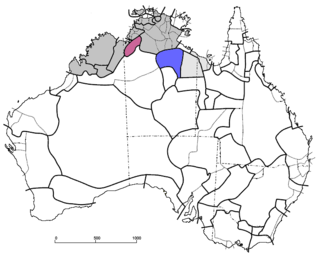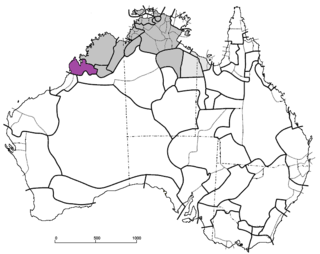Related Research Articles
The Wilson River language, also known as "Modern" Wankumara, is an Australian Aboriginal language of the Karnic family. It was spoken by several peoples along the Wilson River in Queensland. Of these, the Wanggumara (Wangkumara) and Galali may have migrated from the Bulloo River and abandoned their language when they arrived.

The Tasmanian languages were the languages indigenous to the island of Tasmania, used by Aboriginal Tasmanians. The languages were last used for daily communication in the 1830s, although the terminal speaker, Fanny Cochrane Smith, survived until 1905.

Macro-Pama-Nyungan is an umbrella term used to refer to a proposed Indigenous Australian language family. It was coined by the Australian linguist Nicholas Evans in his 1996 book Archaeology and linguistics: Aboriginal Australia in global perspective, co-authored by Patrick McConvell. The term arose from Evans' theory suggesting that two of the largest Indigenous Australian language families share a common origin, and should therefore be classified as a singular language family under "Macro-Pama-Nyungan".
The Laragiya language, also spelt Larrakia, and also known as Gulumirrgin, is an Australian Aboriginal language spoken by just six people near the city of Darwin in northern Australia as of 1983. Only 14 people claimed to know the Laragiya language in 2016.

The Mirndi or Mindi languages are an Australian language family spoken in the Northern Territory of Australia. The family consists of two sub-groups, the Yirram languages and the Barkly languages some 200 km farther to the southeast, separated by the Ngumpin languages. The primary difference between the two sub-groups is that while the Yirram languages are all prefixing like other non-Pama–Nyungan languages, the Barkly languages are all suffixing like most Pama–Nyungan languages.

The Nyulnyulan languages are a small family of closely related Australian Aboriginal languages spoken in northern Western Australia. Most languages in this family are extinct, with only three extant languages, all of which are almost extinct.
Bardi is an endangered Australian Aboriginal language in the Nyulnyulan family, mutually intelligible with Jawi and possibly other dialects. It is spoken by the Bardi people at the tip of the Dampier peninsula and neighbouring islands. There are few fluent speakers in the 21st century, but efforts are being made to teach the Bardi language and culture at at least one school.

The Wunambal language, also known as Northern Worrorran, Gambera or Gaambera, is a moribund Australian Aboriginal language of Western Australia. It has several dialects, including Yiiji, Gunin, Miwa, and Wilawila. It is spoken by the Wunambal people.
Mary Carmel Charles was an author and the last fluent speaker of the Nyulnyul language of Western Australia. She was born to the Nyulnyul tribe in the Kimberley region of Western Australia at the Beagle Bay Mission. She played an important part in the documentation of the language and the writing of a Nyulnyul grammar, despite the fact that she was deaf.
Murrinh-patha, called Garama by the Jaminjung, is an Australian Aboriginal language spoken by over 2,000 people, most of whom live in Wadeye in the Northern Territory, where it is the dominant language of the community. It is spoken by the Murrinh-Patha people, as well as several other peoples whose languages are extinct or nearly so, including the Mati Ke and Marri-Djabin. It is believed to be the most widely spoken Australian Aboriginal language not belonging to the Pama-Nyungan language family.

Wagiman, also spelt Wageman, Wakiman, Wogeman, and other variants, is a near-extinct Aboriginal Australian language spoken by a small number of Wagiman people in and around Pine Creek, in the Katherine Region of the Northern Territory.
Dalabon is a Gunwinyguan language of Arnhem Land, Australia. It is a severely endangered language, with perhaps as few as three fluent speakers remaining as of 2018. Dalabon is also known as Dangbon, Ngalkbun, and Buwan.
Marra, sometimes formerly spelt Mara, is an Australian Aboriginal language, traditionally spoken on an area of the Gulf of Carpentaria coast in the Northern Territory around the Roper, Towns and Limmen Bight Rivers. Marra is now an endangered language. The most recent survey was in 1991; at that time, there were only 15 speakers, all elderly. Most Marra people now speak Kriol as their main language. The remaining elderly Marra speakers live in the Aboriginal communities of Ngukurr, Numbulwar, Borroloola and Minyerri.
The Burarra language is an Australian Aboriginal language spoken by the Burarra people of Arnhem Land. It has several dialects.
The Ngarnji (Ngarndji) or Ngarnka language was traditionally spoken by the Ngarnka people of the Barkly Tablelands in the Northern Territory of Australia. The last fluent speaker of the language died between 1997 and 1998. Ngarnka belongs to the Mirndi language family, in the Ngurlun branch. It is closely related to its eastern neighbours Binbinka, Gudanji and Wambaya. It is more distantly related to its western neighbour Jingulu, and three languages of the Victoria River District, Jaminjung, Ngaliwurru and Nungali. There is very little documentation and description of Ngarnka, however there have been several graduate and undergraduate dissertations written on various aspects of Ngarnka morphology, and a sketch grammar and lexicon of Ngarnka is currently in preparation.

Worrorra, also written Worora and other variants, and also known as Western Worrorran, is a moribund Australian Aboriginal language of northern Western Australia. It encompasses a number of dialects, which are spoken by a group of people known as the Worrorra people.
Olo (Orlei) is a non-Austronesian, Torricelli language of Papua New Guinea. The language is spoken in 55 villages, from the Aitape Township (north) to the Sandaun Province (south), and is at risk of going extinct. Olo is believed to be a Goal Oriented Activation language, meaning the speaker chooses their words with an idea of what they are trying to achieve with the listener in mind, this has been labeled as referential theory. Referential theory has been divided into four groupings, all of which come with disadvantages, recency, episodes, prominence, and memorial activation.
The Jabirr Jabirr language, also known as Djabirr-Djabirr, is a Western Nyulnyulan language formerly spoken by the Jabirr Jabirr people on the coast south of Beagle Bay in Western Australia. Earlier sources spelled the name DjaberrDjaberr or Dyaberdyaber; the contemporary accepted spelling is Jabirr-Jabirr, which reflects the spelling conventions of languages of the Kimberley region. It is also sometimes spelt Jabba Jabba.

The Bardi people, also spelt Baada or Baardi and other variations, are an Aboriginal Australian people, living north of Broome and inhabiting parts of the Dampier Peninsula in the Kimberley region of Western Australia. They are ethnically close to the Jawi people, and several organisations refer to the Bardi Jawi grouping, such as the Bardi Jawi Niimidiman Aboriginal Corporation Registered Native Title Body (RNTBC) and the Bardi Jawi Rangers.
William Bernard McGregor is an Australian linguist and professor in linguistics at Aarhus University. He specializes in the description of mainly non-Pama-Nyungan Australian languages and does descriptive linguistic work on Gooniyandi, Nyulnyul and Warrwa, but also studies the Shua language in Africa. He works on theoretical and typological issues from within a variation of systemic functional linguistics dubbed Semiotic Grammar developed by himself.
References
- ↑ K13 Nyulnyul at the Australian Indigenous Languages Database, Australian Institute of Aboriginal and Torres Strait Islander Studies
- ↑ Charles, Mary (2000) [1993]. Winin – Why the Emu Cannot Fly. Translated by William B. McGregor. Broome, WA: Magabala Books. ISBN 1-875641-07-6.
- ↑ McGregor, William B. (2011). The Nyulnyul language of Dampier land, Western Australia. Volume 1: Grammar. Canberra: Pacific Linguistics. p. 65. ISBN 9780858836471 . Retrieved 10 October 2022.
- ↑ McGregor, William B. (2011). The Nyulnyul language of Dampier land, Western Australia. Volume 1: Grammar. Canberra: Pacific Linguistics. p. 65. ISBN 9780858836471 . Retrieved 10 October 2022.
- ↑ Bowern, C. 2010. Two Missing Pieces in a Nyulnyulan Jigsaw Puzzle. "Linguistic Society of America Extended Abstracts".
- 1 2 3 McGregor, William B. (2011). The Nyulnyul language of Dampier Land, Western Australia (PDF). Canberra: Pacific Linguistics, Australian National University. ISBN 9780858836471 . Retrieved 10 April 2022.